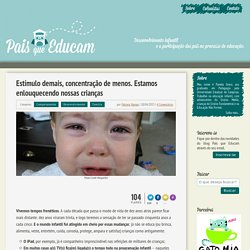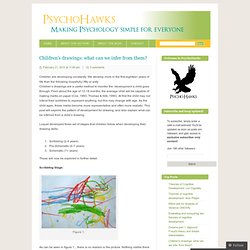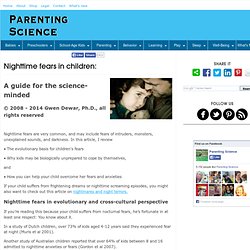

Estímulo demais, concentração de menos. Estamos enlouquecendo nossas crianças - Pais que Educam. Vivemos tempos frenéticos.

A cada década que passa o modo de vida de dez anos atrás parece ficar mais distante: dez anos viraram trinta, e logo teremos a sensação de ter se passado cinquenta anos a cada cinco. E o mundo infantil foi atingido em cheio por essas mudanças: já não se educa (ou brinca, alimenta, veste, entretém, cuida, consola, protege, ampara e satisfaz) crianças como antigamente: Birth Of Memory: Why Kids Forget What Happened Before Age 7. Recently, my nearly-4-year-old niece suffered the kind of childhood accident every parent dreads: she fell off her bike and broke a front tooth high above the gum line.

The resulting pain and eventual extraction were a harrowing experience for her parents, but fortunately the little girl emerged with a cheery attitude: “Now I can slurp noodles through the gap,” she told me over the holidays. Fortunately, she probably won’t remember any of this when she’s an adult. By the time she’s in second grade, the entire experience will be a dim memory captured in pictures.
And that’s because of a strange phenomenon known as childhood amnesia. Kids can remember events before the age of 3 when they’re small, but by the time they’re a bit older, those early autobiographical memories are lost. Scientists have long wondered about the cause of this baffling memory-loss, and thought that language development might have something to do with it. The result? Therapeutic activities for children. Rhinebeck Child and Family Center, LLC - Home Page.
Self Esteem and Character Building Activities for Kids. Self Esteem by definition is a realistic respect for or favorable impression of oneself.

It’s very important for a child to feel good about themselves. Statistics show that children with low self esteem tend to perform below their potential in school and make poor decisions in social situations. Magnificent Creations Limitee - Home. Www.self-esteem-experts.com/support-files/tootyourhornworksheet.pdf. The Middle Child Syndrome.
When planning your family, it is important to consider how the birth order will impact your children’s emotions and personality, as well as your family’s dynamics.

There is a phenomenon often talked about, called the “Middle Child Syndrome,” which helps explain how birth order affects every aspect of a child’s life. Wondering what your middle child may be experiencing, or how to possibly counteract any negativity caused from being a middle child? Here is some information to help! Help your middle child feel like an important member of your family by having special date nights! Emotional Impact Dr. Middle children often feel left out and invisible, a contrast from their older and younger siblings. Some studies suggest that middle children are also more prone to depression and typically have stronger immune systems than their older siblings.
PersonalityAccording to these studies, middle children tend to be more outgoing and flexible than their older and younger siblings. Born In Between. Children’s drawings: what can we infer from them? February 21, 2010 at 11:00 am Children are developing constantly.

We develop more in the first eighteen years of life than the following (hopefully) fifty or sixty. Children’s drawings are a useful method to monitor the development a child goes through. From about the age of 12-18 months, the average child will be capable of making marks on paper (Cox, 1993; Thomas & Silk, 1990). At first the child may not intend their scribbles to represent anything, but this may change with age. Luquet developed three set of stages that children follow when developing their drawing skills: Scribbling (2-4 years)Pre-Schematic (4-7 years)Schematic (7+ years) These will now be explored in further detail. Scribbling Stage: Figure 1. As can be seen in figure 1., there is no realism in the picture.
Interpret Drawings For Play Therapy & Art Counseling. Use the below art therapy interpretation drawings information as a quick reference guide to your art therapy practice.

Quick Reference: Learn To Interpret At- Risk Clients Through Play Therapy & Art Counseling Drawings. Placement of a Play Therapy Drawing: Top of page: Lives in a fantasy world, withdrawn, avoids others Bottom of page: Insecure, dependent, needy Middle of page: Range of normalcy Heavy pressure on drawing of lines: Trauma or Aggression Light pressure: Fear Shading: Anxiety, if on genitals then possible sexual abuse or sexual identity conflict Lots of details in the drawing: Possible sexual abuse or need to control.
InterpretingChildren'sHumanFigureDrawings. Drawing Development in Children. Young_in_art. Nighttime fears in children. © 2008 - 2014 Gwen Dewar, Ph.D., all rights reserved Nighttime fears are very common, and may include fears of intruders, monsters, unexplained sounds, and darkness.

In this article, I review • The evolutionary basis for children's fears • Why kids may be biologically unprepared to cope by themselves, and • How you can help your child overcome her fears and anxieties If your child suffers from frightening dreams or nighttime screaming episodes, you might also want to check out this article on nightmares and night terrors.